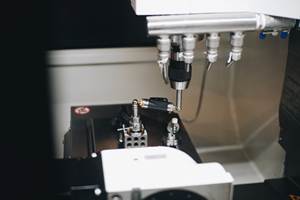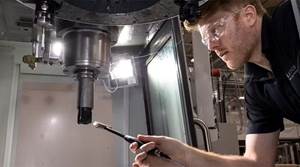Getting to Know Glebar
This grinding machine manufacturer recently consolidated its three U.S. operations into a new facility in New Jersey and added a range of new production machining equipment.
Share





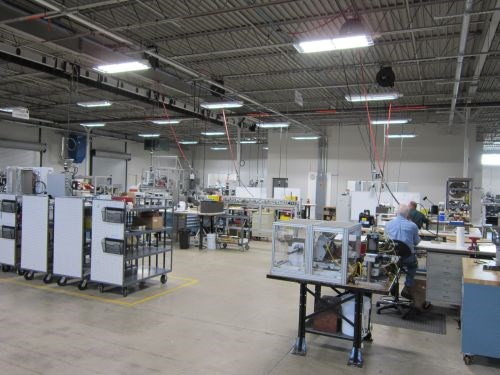
Glebar’s new 44,560-square-foot facility represents a consolidation of three other locations and features an eco-friendly design and improved workflow for the production of its range of grinding machines.
I must admit, until recently, I didn’t know as well as I would have liked to. That’s why I was glad to attend the grinding machine manufacturer’s open house last week to celebrate the opening of its new headquarters in Ramsey, New Jersey.
Glebar was founded in 1952 by Miner Gleason (the “gle”) and Robert Barhorst (the “bar”) as a manufacturer of centerless plunge-grinding machines. In the 1960s, it adapted its plunge grinding technology to form billiard balls and golf ball cores. (To this day, 90 percent of all golf ball cores are produced on Glebar equipment.) The company’s product portfolio has since expanded to include OD grinders, double-disc grinders, CNC roll rubber grinders with SCARA-robot feeding systems, CNC serrated-steel rule grinders, CAM grinding systems, dressing machines and Ferris wheel grinders. Glebar serves many markets, including medical, metals, automotive and aerospace, and all of its equipment is made here in the States.
Adam Cook, CEO, says that after operating for more than 60 years in Franklin Lakes, New Jersey, Glebar consolidated its three locations and moved to its larger facility in Ramsey to accommodate the company’s recent growth and international expansion. Its new 44,560-square-foot headquarters features LED lighting, updated power systems and eco-friendly features to reduce energy consumption, as well as new manufacturing and inspection equipment, including HMC, VMC, EDM and turning center equipment. The new facility with open layout also enables the company to facilitate workflow through the shop and more effectively implement a lean manufacturing mindset.
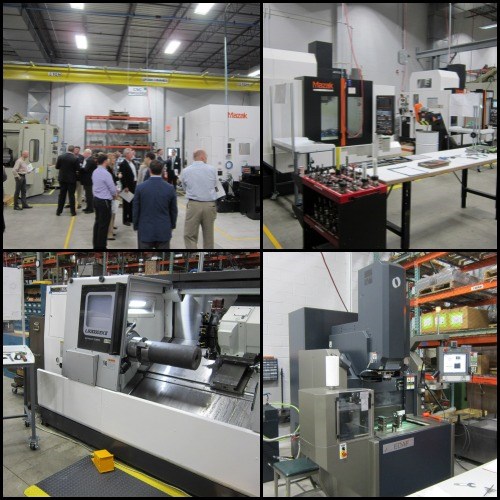
Glebar has invested in a number of new machining centers for its shop area, including HMC, VMC, EDM and turning center equipment. At some point, a pallet-pool system will be added to the new Mazak Nexus 6800-II HMC.
Glebar designs its grinding equipment to be modular so it can tailor systems per customers’ applications to enable automation, in-process feedback and intuitive programming and operating. One good example is its CAM2 micro-grinding machine for medical guidewire and other small components. This machine, which can accommodate workpiece stock as small as 0.005 inch in diameter and offers a minimal grinding diameter of 0.0005 inch, can be configured with an in-line gage, wire cutter and wire extractor, spool feeder and cutting system, vacuum feeding system, programmable part extractor and so on.
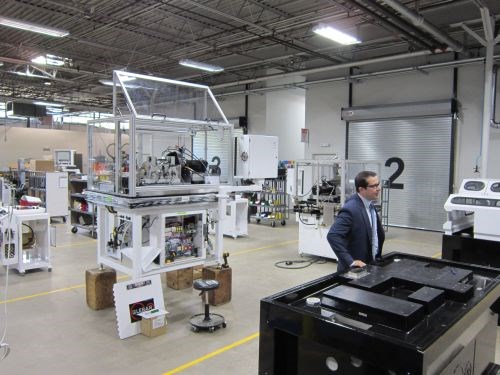
The company’s CAM2 micro-grinding machines are commonly used to grind medical guidewires for minimally invasive surgical procedures as well as small parts for dental and other applications. The machines accommodate workpiece stock as small as 0.005 inch in diameter and offers a minimal grinding diameter of 0.0005 inch.
It can also be used in conjunction with the company’s new P4K gaging system, a profile metrology device that uses high-speed optical micrometer technology whereby a part is pulled through a laser gage via a precision linear stage while matching diameter and length readings in real time at a rate of 10,000 readings per second (these readings are taken every 30 millionths of an inch). The P4K can scan and feed back diameter measurements to the grinding machine, including taper and radii, to automatically correct wheel dress shape.
Related Content
Ballbar Testing Benefits Low-Volume Manufacturing
Thanks to ballbar testing with a Renishaw QC20-W, the Autodesk Technology Centers now have more confidence in their machine tools.
Read MoreOrthopedic Event Discusses Manufacturing Strategies
At the seminar, representatives from multiple companies discussed strategies for making orthopedic devices accurately and efficiently.
Read More4 Commonly Misapplied CNC Features
Misapplication of these important CNC features will result in wasted time, wasted or duplicated effort and/or wasted material.
Read MoreHow to Mitigate Chatter to Boost Machining Rates
There are usually better solutions to chatter than just reducing the feed rate. Through vibration analysis, the chatter problem can be solved, enabling much higher metal removal rates, better quality and longer tool life.
Read MoreRead Next
AMRs Are Moving Into Manufacturing: 4 Considerations for Implementation
AMRs can provide a flexible, easy-to-use automation platform so long as manufacturers choose a suitable task and prepare their facilities.
Read MoreMachine Shop MBA
Making Chips and 91ÊÓƵÍøÕ¾ÎÛ are teaming up for a new podcast series called Machine Shop MBA—designed to help manufacturers measure their success against the industry’s best. Through the lens of the Top Shops benchmarking program, the series explores the KPIs that set high-performing shops apart, from machine utilization and first-pass yield to employee engagement and revenue per employee.
Read MoreLast Chance! 2025 Top Shops Benchmarking Survey Still Open Through April 30
Don’t miss out! 91ÊÓƵÍøÕ¾ÎÛ's Top Shops Benchmarking Survey is still open — but not for long. This is your last chance to a receive free, customized benchmarking report that includes actionable feedback across several shopfloor and business metrics.
Read More

















